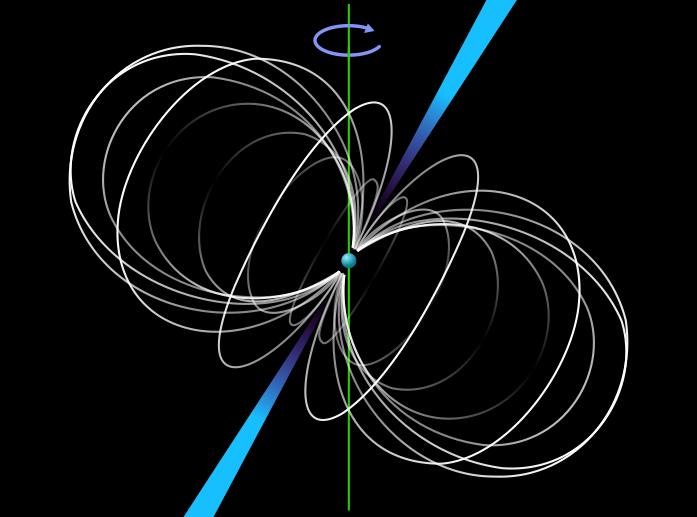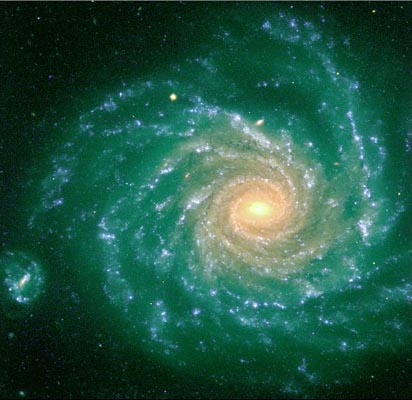Stars and Stellar Evolution : Lecture 15
Stellar Death for Stars with Mass > 4.0 Ms
These stars have a different end. Since they are larger central pressures will
allow Carbon burning so the Star will burn further and produce Neon.
If M > 9.0
Ms
pressures will be enough to burn Neon. From these processes heavy elements
up to Iron can be formed. In fact a high mass star will have shells of different
fusion processes.
Stages of a 25 Ms Star
| Stage | Temperature | Duration |
| Hydrogen Burning | 4x107 | 7 x 106 yrs |
| Helium burning | 2 x 108 |
7 x 105 yrs |
| Carbon | 6 x 108 | 600 yrs |
| Neon | 1.2 x 109 | 1 yr |
| Oxygen | 1.5 x 109 | 6 months |
| Silicon | 2.7 x 109 | 1 day |
When silicon burning is finished that is it. No more fuel of any type. The Iron
core then must collapse. An atom has a size of 10-10 m.
A nucleous has a size
of 10-15m. Pressures become so intense that the nuclei are all pushed
together - this occures when densities are circa 1015 times those for normal
matter. Once pushed together the nuclei can go no further - the sun is
essentially one huge nuclei held firm by gravity. The collapse of the core is
frightenly fast and takes place in milliseconds. As the core gets pushed
together the matter, which is a mixture of protons, neutron and electrons we
reduced to
neutrons via
e+ p --> n +neutrino
The neutrinos will be radiated off in a huge flash and the core will be a single
mass of neutrons.
After this happens the outer layers collapse (This takes rather longer - around
1 second!)
and "rebound" off the core and get
blasted out to space. This is called a Supernova (type II). These
events can be spotted.
In 1987 a relatively close star went nova. After a few
months the brightness dies down. Historically supernova can be bright enough to
be
seen during the day.
- Eta-Carinae This star is a large star very near its end. It is surrounded by the nebulae shown. The nebula is changing quickly enough so that (sligh) changes are visable over the few years it has been imaged by HST. It may go supernoae anytime!
Neutron Stars
The left over neutron core from a supernova forms a neutron star
The mass will be very much less than that of the original star. For our 25 Ms
example we expect the explosion to throw 24 Ms of material out leaving a
neutron star of mass
1Ms behind.
A neutron star is a very extreme object. Fortunately we have been able to
observe neutron stars (in some sense.) A famous example, and a good story, is
the Crab nebulae. On july 4th 1054 a supernova went pop a mere 6500 light years
away. (By contrast SN1987a was 160,000 Lyr away). This was a truly spectacular
event and the resulting object was visable in the daytime sky for the
rest of july. It has of course faded significantly since then. Fortunately for
us
an astronomer of the Chinese court Yang Wei-T'e recorded very carefully the
position of the supernova (and to quote I make my kowtow. I observed the
phenomena of a guest star. It's colour was slightly iridesant. Following an
order of the Emporer, I respectively make the prediction will not disturb
aldebaron. This indicates.... the Empire will gain great power. )
The Crab Nebula is in Taurus (not Cancer as I said in the lecture).
at the position recorded by Yang Wei-T'e is today a pulsar . Pulsars
were originaly observed by the young UK astronomer Jocyln Bell. The Crab pulsar
is basically a flashing star. its period is 0.033 secs so it flashes about 30
times per second. It is now realised that pulsars are neutron stars.
Neutron stars are very extreme objects. The have collaspsed from a star to about
a very dense object. The expected density of the star is about
1017 kg/m3.
Neutron stars rotate very quickly. This is because of conservation of
angular momentum
. Collapsing objects rotate faster.
(incidentally this is
the cause of Keplers second Law.). Roughly if an object has a size R and is
rotating with a period P then
P/R2 = constant
(This is an extra aside for those interested.)
Something the size of the sun, rotating once per month, collapses to a size R=30km
then its new period is
P(new) = P(old) x R2 (new)/R2 (old)
= (30x24x60^2 sec) x30 / 700,0002
=0.004 secs
which is an incredibly fast rotation!
The speedy rotation and intense gravity give rise to extremely strong
magnetic fields. Particles falling onto the neutron star generate two beams of light.
The precession of the neutron star then leads to a pulsating signal to an observer.

© Dave Dunbar 2020






